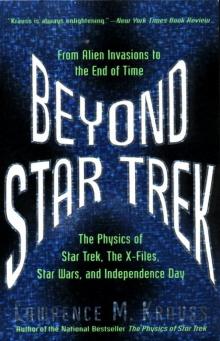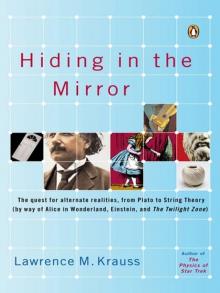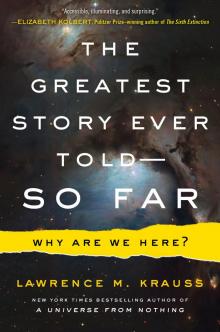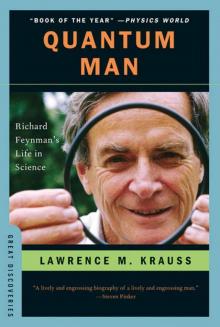- Home
- Lawrence M. Krauss
The Greatest Story Ever Told—So Far
The Greatest Story Ever Told—So Far Read online
Praise for The Greatest Story Ever Told—So Far
“In every debate I’ve done with theologians and religious believers, their knock-out final argument always comes in the form of two questions: Why is there something rather than nothing? and Why are we here? The presumption is that if science provides no answers then there must be a God. But God or no, we still want answers. In A Universe from Nothing Lawrence Krauss, one of the biggest thinkers of our time, addressed the first question with verve, and in The Greatest Story Ever Told he tackles the second with elegance. Both volumes should be placed in hotel rooms across America, in the drawer next to the Gideon Bible.”
—Michael Shermer, publisher of Skeptic magazine, columnist for Scientific American, and author of The Moral Arc
“A Homeric tale of science, history, and philosophy revealing how we learned so much about the universe and its tiniest parts.”
—Sheldon Glashow, Nobel laureate in physics
“Discovering the bedrock nature of physical reality ranks as one of humanity’s greatest collective achievements. This book gives a fine account of the main ideas and how they emerged. Krauss is himself close to the field and can offer insights into the personalities who have led the key advances. A practiced and skilled writer, he succeeds in making the physics ‘as simple as possible but no simpler.’ I don’t know a better book on this subject.”
—Martin Rees, author of Just Six Numbers
“It is an exhilarating experience to be led through this fascinating story, from Galileo to the Standard Model and the Higgs boson and beyond, with lucid detail and insight, illuminating vividly not only the achievements themselves but also the joy of creative thought and discovery, enriched with vignettes of the remarkable individuals who paved the way. It amply demonstrates that the discovery that ‘nature really follows the simple and elegant rules intuited by the twentieth- and twenty-first-century versions of Plato’s philosophers’ is one of the most astonishing achievements of the human intellect.”
—Noam Chomsky, Institute Professor & Professor of Linguistics (emeritus), MIT
“Charming . . . Krauss has written an account with sweep and verve that shows the full development of our ideas about the makeup of the world around us. . . . A great romp.”
—Walter Gilbert, Nobel laureate in chemistry
“I loved the fight scenes and the sex scenes were excellent.”
—Eric Idle
Thank you for downloading this Simon & Schuster ebook.
* * *
Get a FREE ebook when you join our mailing list. Plus, get updates on new releases, deals, recommended reads, and more from Simon & Schuster. Click below to sign up and see terms and conditions.
CLICK HERE TO SIGN UP
Already a subscriber? Provide your email again so we can register this ebook and send you more of what you like to read. You will continue to receive exclusive offers in your inbox.
CONTENTS
Prologue
Part One: Genesis
* * *
Chapter 1: From the Armoire to the Cave
Chapter 2: Seeing in the Dark
Chapter 3: Through a Glass, Lightly
Chapter 4: There, and Back Again
Chapter 5: A Stitch in Time
Chapter 6: The Shadows of Reality
Chapter 7: A Universe Stranger than Fiction
Chapter 8: A Wrinkle in Time
Chapter 9: Decay and Rubble
Chapter 10: From Here to Infinity: Shedding Light on the Sun
Part Two: Exodus
* * *
Chapter 11: Desperate Times and Desperate Measures
Chapter 12: March of the Titans
Chapter 13: Endless Forms Most Beautiful: Symmetry Strikes Back
Chapter 14: Cold, Stark Reality: Breaking Bad or Beautiful?
Chapter 15: Living inside a Superconductor
Chapter 16: The Bearable Heaviness of Being: Symmetry Broken, Physics Fixed
Part Three: Revelation
* * *
Chapter 17: The Wrong Place at the Right Time
Chapter 18: The Fog Lifts
Chapter 19: Free at Last
Chapter 20: Spanking the Vacuum
Chapter 21: Gothic Cathedrals of the Twenty-First Century
Chapter 22: More Questions than Answers
Chapter 23: From a Beer Party to the End of Time
Epilogue: Cosmic Humility
Acknowledgments
About the Author
Index
For Nancy
These are the tears of things,
and the stuff of our mortality
cuts us to the heart.
—VIRGIL
PROLOGUE
The hardest thing of all to see is what is really there.
—J. A. BAKER, THE PEREGRINE
In the beginning there was light.
But more than this, there was gravity.
After that, all hell broke loose. . . .
This is how the story of the greatest intellectual adventure in history might properly be introduced. It is a story of science’s quest to uncover the hidden realities underlying the world of our experience, which required marshaling the very pinnacle of human creativity and intellectual bravery on an unparalleled global scale. This process would not have been possible without a willingness to dispense with all kinds of beliefs and preconceptions and dogma, scientific and otherwise. The story is filled with drama and surprise. It spans the full arc of human history, and most remarkably, the current version isn’t even the final one—just another working draft.
It’s a story that deserves to be shared far more broadly. Already in the first world, parts of this story are helping to slowly replace the myths and superstitions that more ignorant societies found solace in centuries or millennia ago. Nevertheless, thanks to the directors George Stevens and David Lean, the Judeo-Christian Bible is still sometimes referred to as “the greatest story ever told.” This characterization is astounding because, even allowing for the frequent sex and violence, and a bit of poetry in the Psalms, the Bible as a piece of literature arguably does not compare well to the equally racy but less violent Greek and Roman epics such as the Aeneid or the Odyssey—even if the English translation of the Bible has served as a model for many subsequent books. Either way, as a guide for understanding the world, the Bible is pathetically inconsistent and outdated. And one might legitimately argue that as a guide for human behavior large swaths of it border on the obscene.
In science, the very word sacred is profane. No ideas, religious or otherwise, get a free pass. For this reason the pinnacle of the human story did not conclude with a prophet’s sacrifice two thousand years ago, any more than it did with the death of another prophet six hundred years later. The story of our origins and our future is a tale that keeps on telling. And the story is getting more interesting all the time, not due to revelation, but due to the steady march of scientific discovery.
Contrary to many popular perceptions, this scientific story also encompasses both poetry and a deep spirituality. But this spirituality has the additional virtue of being tied to the real world—and not created in large part to appease our hopes and dreams.
The lessons of our exploration into the unknown, led not by our desires, but by the force of experiment, are humbling. Five hundred years of science have liberated humanity from the shackles of enforced ignorance. By this standard, what cosmic arrogance lies at the heart of the assertion that the universe was created so that we could exist? What myopia lies at the heart of the assumption that the universe of our experience is characteristic of the universe throughout all of time and space?
This
anthropocentrism has fallen by the wayside as a result of the story of science. What replaces it? Have we lost something in the process, or as I shall argue, have we gained something even greater?
I once said at a public event that the business of science is to make people uncomfortable. I briefly regretted the remark because I worried that it would scare people away. But being uncomfortable is a virtue, not a hindrance. Everything about our evolutionary history has primed our minds to be comfortable with concepts that helped us survive, such as the natural teleological tendency children have to assume objects exist to serve a goal, and the broader tendency to anthropomorphize, to assign agency to lifeless objects, because clearly it is better to mistake an inert object for a threat than a threat for an inert object.
Evolution didn’t prepare our minds to appreciate long or short timescales or short or huge distances that we cannot experience directly. So it is no wonder that some of the remarkable discoveries of the scientific method, such as evolution and quantum mechanics, are nonintuitive at best, and can draw most of us well outside our myopic comfort zone.
This is also what makes the greatest story ever told so worth telling. The best stories challenge us. They cause us to see ourselves differently, to realign our picture of ourselves and our place in the cosmos. This is not only true for the greatest literature, music, and art. It is true of science as well.
In this sense it is unfortunate that replacing ancient beliefs with modern scientific enlightenment is often described as a “loss of faith.” How much greater is the story our children will be able to tell than the story we have told? Surely that is the greatest contribution of science to civilization: to ensure that the greatest books are not those of the past, but of the future.
Every epic story has a moral. In ours, we find that letting the cosmos guide our minds through empirical discovery can produce a great richness of spirit that harnesses the best of what humanity has to offer. It can give us hope for the future by allowing us to enter it with our eyes open and with the necessary tools to actively participate in it.
• • •
My previous book, A Universe from Nothing, described how the revolutionary discoveries over the past hundred years have changed the way we understand our evolving universe on its largest scales. This change has led science to begin to directly address the question “Why is there something rather than nothing?”—which was formerly religious territory—and rework it into something less solipsistic and operationally more useful.
Like A Universe from Nothing, this story also originated in a lecture I presented, in this case at the Smithsonian Institution in Washington, DC, which generated some excitement at the time, and as a result I was once again driven to elaborate upon the ideas I started to develop there. In contrast to A Universe from Nothing, in this book I explore the other end of the spectrum of our knowledge and its equally powerful implications for understanding age-old questions. The profound changes over the past hundred years in the way we understand nature at its smallest scales are allowing us to similarly co-opt the equally fundamental question “Why are we here?”
We will find that reality is not what we think it is. Under the surface are “weird,” counterintuitive, invisible inner workings that can challenge our preconceptions of what makes sense as much as a universe arising from nothing might.
And like the conclusion I drew in my last book, the ultimate lesson from the story I will tell here is that there is no obvious plan or purpose to the world we find ourselves living in. Our existence was not preordained, but appears to be a curious accident. We teeter on a precarious ledge with the ultimate balance determined by phenomena that lie well beneath the surface of our experience—phenomena that don’t rely in any way upon our existence. In this sense, Einstein was wrong: “God” does appear to play dice with the universe, or universes. So far we have been lucky. But like playing at the craps table, our luck may not last forever.
• • •
Humanity took a major step toward modernity when it dawned in our ancestors’ consciousness that there is more to the universe than meets the eye. This realization was probably not accidental. We appear to be hardwired to need a narrative that transcends and makes sense of our own existence, a need that was probably intimately related to the rise of religious belief in early human societies.
By contrast, the story of the rise of modern science and its divergence from superstition is the tale of how the hidden realities of nature were uncovered by reason and experiment through a process in which seemingly disparate, strange, and sometimes threatening phenomena were ultimately understood to be connected just beneath the visible surface. Ultimately these connections dispelled the goblins and fairies that had earlier spawned among our ancestors.
The discovery of connections between otherwise seemingly disparate phenomena is, more than any other single indicator, the hallmark of progress in science. The many classic examples include Newton’s connection of the orbit of the Moon to a falling apple; Galileo’s recognition that vastly different observed behaviors for falling objects obscure that they are actually attracted to the earth’s surface at the same rate; and Darwin’s epic realization that the diversity of life on Earth could arise from a single progenitor by the simple process of natural selection. None of these connections was all that obvious, at first. However, after the relationship comes to light and becomes clear, it prompts an “Aha!” experience of understanding and familiarity. One feels like saying, “I should have thought of that!”
Our modern picture of nature at its most fundamental scale—the Standard Model, as it has become called—contains an embarrassment of riches, connections that are far removed from the realm of everyday experience. So far removed that it is impossible without some grounding to make the leap in one step to visualize them.
Not surprisingly, such a single leap never occurred historically, either. A series of remarkable and unexpected and seemingly unrelated connections emerged to form the coherent picture we now have. The mathematical architecture that has resulted is so ornate that it almost seems arbitrary. “Aha!” is usually the furthest thing from the lips of the noninitiated when they hear about the Higgs boson or Grand Unification of the forces of nature.
To move beyond the surface layers of reality, we need a story that connects the world we know with the deepest corners of the invisible world all around us. We cannot understand that hidden world with intuitions based solely on direct sensation. That is the story I want to tell here. I will take you on a journey to the heart of those mysteries that lie at the edge of our understanding of space, time, and the forces that operate within them. My goal is not to unnecessarily provoke or offend, but to prod you, just as we physicists ourselves have been prodded and dragged by new discoveries into a new reality that is at once both uncomfortable and uplifting.
Our most recent discoveries about nature’s fundamental scales have chillingly altered our perception of the inevitability of our presence in the universe. They provide evidence too that the future will no doubt be radically different from what we might otherwise have imagined, and they too further decrease our cosmic significance.
We might prefer to deny this uncomfortable, inconvenient reality, this impersonal, apparently random universe, but if we view it in another context, all of this need not be depressing. A universe without purpose, which is the way it is as far as I can tell, is far more exciting than one designed just for us because it means that the possibilities of existence are so much more diverse and far ranging. How invigorating it is to find ourselves with an exotic menagerie to explore, with laws and phenomena that previously seemed beyond our wildest dreams, and to attempt to untangle the knotted confusion of experience and to search for some sense of order beneath. And how fascinating it is to discover that order, and to piece together a coherent picture of the universe on scales far beyond those that we may ever directly experience—a picture woven together by our ability to predict what will happen next, and the consequent abili
ty to control the environment around us. How lucky to have our brief moment in the Sun. Every day that we discover something new and surprising, the story gets even better.
Part One
* * *
GENESIS
Chapter 1
* * *
FROM THE ARMOIRE TO THE CAVE
The simple inherit folly, but the prudent are crowned with knowledge.
—PROVERBS 14:18
In my beginning there was light.
Surely there was light at the beginning of time, but before we can get to the beginning of time, we will need to explore our own beginnings, which also means exploring the beginning of science. And that means returning to the ultimate motive for both science and religion: the longing for something else. Something beyond the universe of our experience.
For many people, that longing translates into something that gives meaning and purpose to the universe and extends to a longing for some hidden place that is better than the world in which we live, where sins are forgiven, pain is absent, and death does not exist. Others, however, long for a hidden place of a very different sort, the physical world beyond our senses, the world that helps us understand how things behave the way they do, rather than why. This hidden world underlies what we experience, and the understanding of it gives us the power to change our lives, our environment, and our future.
The contrast between these two worlds is reflected in two very different works of literature.
The first, The Lion, the Witch and the Wardrobe, by C. S. Lewis, is a twentieth-century children’s fantasy with decidedly religious overtones. It captures a childhood experience most of us have had—looking under the bed or in the closet or in the attic for hidden treasure or evidence that there is more out there than what we normally experience. In the book, several schoolchildren discover a strange new world, Narnia, by climbing into a large wardrobe in the country house outside London where they have been sequestered for their protection during the Second World War. The children help save Narnia with the aid of a lion, who lets himself be humiliated and sacrificed, Christlike, at an altar in order to conquer evil in his world.

 Beyond Star Trek
Beyond Star Trek Hiding in the Mirror: The Quest for Alternate Realities, From Plato to String Theory (By Way of Alicein Wonderland, Einstein, and the Twilight Zone)
Hiding in the Mirror: The Quest for Alternate Realities, From Plato to String Theory (By Way of Alicein Wonderland, Einstein, and the Twilight Zone) The Greatest Story Ever Told—So Far
The Greatest Story Ever Told—So Far Quantum Man: Richard Feynman's Life in Science
Quantum Man: Richard Feynman's Life in Science